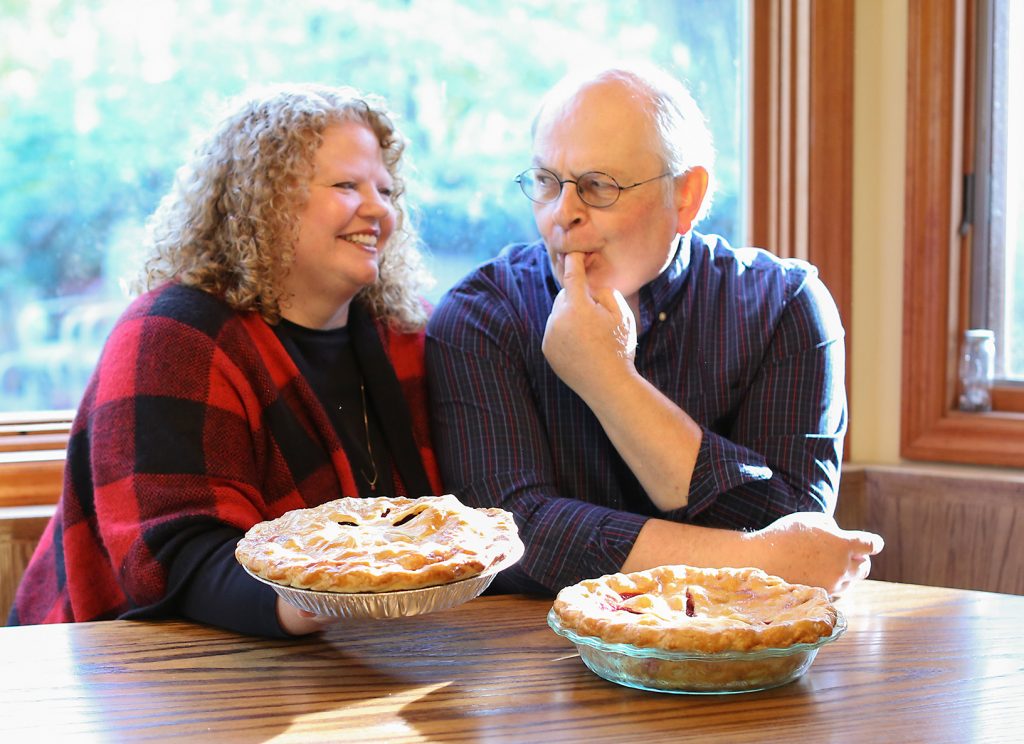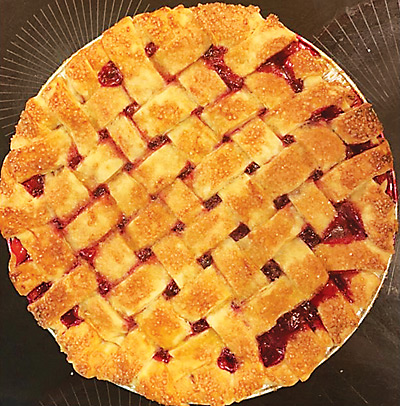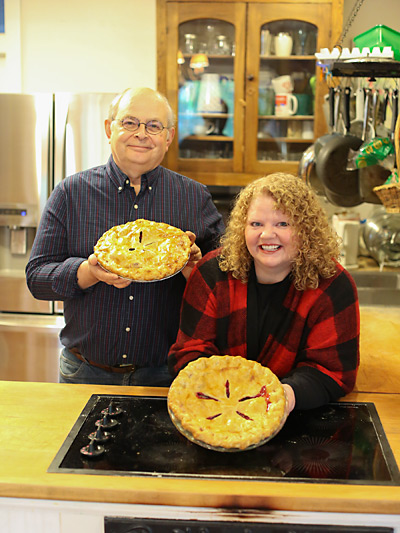
Just as the earliest pizza pies were considered “peasant food,” invented to fill hungry Italian bellies with the most easily obtainable ingredients, traditional American and British pies also had humble beginnings. There was a time when pie crust was entirely inedible—can you imagine?—used only as a means of preserving its contents. Charles Dickens himself called pie “an economical investment for all miscellaneous savings.” Pie was practical, not poetic. Now we consider it the food of the gods.
Most of us don’t bust out the rolling pin until the holidays, but Tena Edlin—local songbird, theater artist, middle school language arts teacher, and wife of a legit Brit—has firmly decided there is no incorrect season, or reason, to make a pie.
What began as a pre-wedding whim—resulting in a lot of pie-baking items on her registry and a few cockeyed comments from her husband—“Are you ever gonna use that pie stuff?”—has turned into a full-on pastry passion and a delightful five-year series of mouthwatering visuals on Instagram: @kinnick72, #mmmpie. With half a decade’s bakes under her belt—tantalizing thank-you pies, pies for auctions, and birthday-gift pies among them—Tena was bound to have a few tasty nuggets to impart about the pie-verse, especially during a month when pie is particularly top of mind.
Better Late Than Never
As a little girl, helping her mom crimp the crust “was a pretty big deal,” but it was as far as she’d ever gotten. “I wanted to learn how to make pie,” she told me quite simply.
“I guess maybe it was kind of a thing, like, my mom was a wicked bread baker, my grandma’s thing was really homemade noodles. Maybe my thing could be pie?” At age 43, she made her first.
Why pie? Her curiosity was piqued upon reading Iowa author Beth Howard’s Ms. American Pie. “That story fascinated me,” Tena tells me over an iced latte in the park. “I read her book, and then I read her cookbook. And she just had this very open feeling about pie, like anybody can make pie. And I was like, ‘Okay, I can do this!’”
“And another thing is, I’m obsessed with the movie Waitress,” she adds. “Keri Russell. And Andy Griffith, he plays this old curmudgeon. She’s a waitress in the pie shop, and her gift … is pie. She has the coolest names for her pies and this knack for putting stuff together. I was just always like, ‘That’s so fun! I could just invent pies!’”
Gooseberry Beginnings
Pie #1 was baked on June 30, 2015, the summer after Andrew and Tena tied the knot. “Oh my god, the crust looks so bad,” she says, scrolling to her first Instagram #mmmpie post, “compared to what I can do now, ya know?
“It was a gooseberry pie,” she explains, “because it’s my dad’s favorite.” Her father has a century farm north of Fairfield that’s “not great for finding mushrooms, I don’t have the holy grail there, but it’s great for gooseberries. And Andrew loves gooseberries. The funny thing was, Andrew did not understand wild gooseberries—because in England they’re like, tame, and I’m not kidding you, they’re the size of grapes! Well, when I brought the bucket of berries, he was like, ‘What are these?’ And I’m like, ‘They’re gooseberries.’ And he was like, ‘You expect me to stem these?’ I’m like, ‘Honey, these are the gooseberries!’” To save the marriage, only two of Tena’s pies thus far have involved the dreaded double-stemmed, labor-intensive wild Iowa gooseberry.
Never tasted a gooseberry pie? Well pucker up, man. “Oh my lord, it’s tart like you can’t even believe,” Tena says, “Sour, sour, sour. But it doesn’t taste like any other fruit. It tastes like … gooseberry!”
Feeling Crusty
“The crust is maybe what some people sort of tolerate with a pie,” Tena tells me, “but when the crust is good, it is really good. I use Beth Howard’s crust recipe. It’s really flaky. It’s the one that I started with, and I’ve never wavered. Well. I wavered one time and that was my only crust fail. Like flat. Out. 100 percent. Fail.”
“My crust and I … are in a good place,” Tena laughs. “I feel confident enough with the crust now, that it is a total labor of love. Now when I make a pie, I feel like I’m putting myself into it a little bit, which is cool. And there’s something about when you know that somebody has made a crust from scratch. It forgives a lot, but also you appreciate what they put into it.”
Look at a photo of one of her pies. You can’t help but notice its stunning, sunshiny color. “That is the egg wash!” Tena enthuses, “It makes the difference in how your pie looks. It takes it from just being a plain crust to being shiny and beautiful and golden. And I just don’t know why anyone wouldn’t use an egg wash.”
Here’s another bit of free advice: avoid man-handling your dough. “I’m a hothead and I would heat up the butter too much,” Tena says. “Some people swear by the feel of mixing with their hands, but I go by the looks and save the feel for when I’m near the end. I cut the butter in with the pastry cutter—that we got for our wedding—then ice-cold water, and that’s when I will mix with my fingers.”
Tena’s also been known to try a lattice top from time to time, “the wider, the better,” but she prefers to let the crust’s flavor and texture speak for itself. Back to the basics. “Some people can make the most beautiful crust in the world, like with all these designs, and I think that I’m just so nervous about overworking my dough—overworking is what takes it away from being flaky to being more crunchy, which you don’t want.”
Favorites & Fails
Blueberry pies are the easiest, Tena attests, along with mixed berry pies. Mixing fruit in general is something she likes to try. “It was the end of summer and I’d just watched Waitress, and there is a pie she makes called ‘Summer Sunset,’ peach and strawberry. Those two were really good together.” Incidentally, Summer Sunset is also the perfect descriptor for Tena’s hair.
Another winning combo was a mixture by necessity. Pickings were dismal this year for gooseberries on the farm. After hours of scrounging, Tena only procured two cups’ worth, not enough for a pie, so blueberries became the stand-in savior, a cheerfully sweet balance to the sour. Thus, Pie #44 was dubbed “The Blue Goose.”
Tena tried a strawberry-basil pie once, she tells me, choosing her words carefully. “It tasted very … clean.” Do I detect a hint of sarcasm? “In a good way,” she says, but it sounds like she’s still trying to convince herself.
“Ever hear the saying, ‘Apple pie without cheese is like a kiss without a squeeze?’” I ask her, curious about the apparently popular combo.
“I have never made an apple pie,” she says. The words still ring in my ears. “And it is not a taste thing.” She eats apples all the time. Apples with cheese, no less. “It is completely a texture thing of baked apples. I do not like how they feel on my teeth.”

While I’m picking my jaw up off the ground, she jokes that she avoids apple pie like the plague, and her husband will not eat cherry. When she makes one using her friend Christi’s backyard sour cherries—“they’re just so pretty!”—she’s forced to eat the entire thing herself. Bummer. “If I had to say what my favorite fruit pie is, it’s cherry,” she smiles. “Peach is right up there, though.
“All pies are good when the fruit is in season, but I do love a good pumpkin pie. Also, I like to put a dash of cinnamon in any fruit pie—cinnamon always makes me think of fall.”
I wonder if she has any other tricks of the trade for us fellow bakers as we prepare for the holidays. “One thing I usually forget is the pat of butter right before you put your top crust on. So sometimes I have to sneak it into one of my vent holes! I don’t understand everything about it,” she admits, “I just trust the experts. For some reason, it’s wonderful.”
The thing I adore about Tena—as a person, and as a baker—is that she is the opposite of fussy. Case in point: “I’m a sucker for a fruit pie that’s hot, with vanilla ice cream melting on it,” she says. “And for me, you can just throw it all in a bowl.”
Savory Pie Guy

Being a Brit, Andrew Edlin loves himself some savory pies. “He was very patient as I was learning with my fruit pies—but then he was like,” I can hear the smile creep into her voice, “‘When are we gonna have savory pies?’” Steak & Ale pie, specifically. “Yeah. Steak, potatoes and mushrooms and beer and onion. It’s reeeeeally good. I quadruple the Worcestershire sauce, and I double the garlic. Lemme tell ya, that one is time intensive, but it makes him so freakin’ happy.”
“Have you tried any other savory pies?” I ask.
“No,” she answers, “because I can’t convince him yet that there will be something better than the Steak & Ale.”
Firm Bottoms
“One thing I haven’t mastered on the Steak & Ale is, when you put the hot filling in, it melts the butter in the crust, so that will always have soggy bottom.” We discuss the British “hot-water crust,” as we picture steely-eyed Paul Hollywood on the Great British Baking Show, skeptically turning over a slice to scratch at the bottom with his knife—or a zoom-in on Mary Berry as she taps for laminated firmness with her red acrylic fingernail.
But Tena gets closer to perfecting a firm bottom with every fruit pie she tries. “If it’s too runny and it’s not setting up at all—every fruit is a little different—I use a little cornstarch and a little tapioca, the minute tapioca that I like to get at the Dutchman’s store. The runnier the fruit, the more I lean on the tapioca.”
“Tapioca is one thing Andrew hates,” she chuckles. “It’s from going to boarding school when they would just like, you know, put out this big thing of tapioca pudding—it just grossed him out. So when he found out I was putting tapioca in the pies, he was horrified!” Tena continues to get away with it, though, because luckily “it doesn’t taste like that.”
Pie for Always
Even though Tena Edlin sometimes feels like she’s “still at the baby stage,” there was a defining moment when she knew she was becoming a pie maker. “Somebody asked for the crust recipe, and when I was giving the directions I said something about the feel of it, and they were like, ‘What do you mean?’ and I’m like, ‘Ohhhhhhhh…’ Yeah. After a while you just know the feel of it. When it’s right. That probably came …” she pauses to think, “after 30 pies.”
“I read this book that said you’re an expert after a thousand pies,” she tells me. I have to ask, “Well, how many pies do you intend to bake—how long will you be doing this?”
“Forever,” she says. It’s a very happy forever.
Unlike the quest she recently completed with her husband to visit every single town square in the state of Iowa, the #mmmpie project isn’t one Tena’s going to just check off the list. “Unless people are getting sick of my social media posts,” she says, but stops herself. “Wait. Who cares if people get sick of my social media posts?”
“What I’m proud about is that I decided that I wanted to learn how to bake pie, and I did it. And it’s been really fun. And honestly, it’s not that hard.” But is it really easy as … ?
Tena’s Favorite Recipe for Cherry Pie Filling
5 to 6 cups fresh pitted cherries, about 2-1/2 to 3 pounds
1/2 cup water
2 tablespoons freshly squeezed lemon juice
2/3 cup granulated sugar
4 tablespoons cornstarch
1/4 teaspoon almond extract, optional
In a saucepan over medium heat, combine cherries, water, lemon juice, sugar and cornstarch. Bring to a boil; reduce heat to low, and cook, stirring frequently, for about 10 minutes. Stir in almond extract. Cool slightly before using. Recipe fills one 9″ pie. (From BakingAddiction.com).
Beth Howard’s Basic Pie Crust Recipe—Double Crust
(From Ms. American Pie, reprinted with permission)
2-1/2 cups white all-purpose flour (plus 1/2 cup extra for rolling)
Dash of salt
1/2 cup (1 stick) butter, chilled and cut into chunks
1/2 cup shortening, chilled
Ice water (fill one cup but use only enough to moisten dough)
In a deep bowl, work the butter and shortening into the flour and salt with your hands until you see almond- and pea-sized lumps of butter.
Then, drizzling in ice water a little at a time, “toss” the water around with your fingers spread, as if the flour were a salad and your hands were the salad tongs. Don’t spend a lot of time mixing the dough, just focus on getting it moistened. Translation: With each addition of water, toss about four times and then STOP, add more water, and repeat.
When the dough holds together on its own (and with enough water, it will), do a “squeeze test.” If it falls apart, you need to add more water. If it is soggy and sticky, you might need to sprinkle flour onto it until the wetness is balanced out. The key is to not overwork the dough! It takes very little time, and you’ll be temped to keep touching it, but don’t!
Now divide the dough in two balls (or three, if your pie dishes are smaller) and form each into a disk shape.
Sprinkle flour under and on top of your dough to keep it from sticking to your rolling surface. Roll to a thinness where the dough almost seems transparent.
Measure the size of the dough by holding your pie plate above it. It’s big enough if you have enough extra width to compensate for the depth and width of your dish, plus 1 to 2 inches overhang.
Slowly and gently—SERIOUSLY, TAKE YOUR TIME—lift the dough off the rolling surface, nudging flour under with the scraper as you lift, and fold the dough back. When you are sure your dough is 100 percent free and clear from the surface, bring your pie dish close to it and then drag your pie dough over to your dish. (Holding the folded edge will give you a better grip and keep your dough from tearing.)
Place the folded edge halfway across your dish, allowing the dough of the covered half to drape over the side. Slowly and carefully unfold the dough until it lies fully across the pie dish.
Lift the edges and let gravity ease the dough down to sit snugly in the dish, using the light touch of a finger if you need to push any remaining air space out of the corners as you go.
Trim excess dough to about 1 inch from the dish edge (I use scissors), leaving ample dough to make crimped, fluted edges.
